Themed collection Web Collection: Surface-Enhanced Raman Scattering (SERS)

Tip-enhanced Raman scattering (TERS ) and high-resolution bio nano-analysis—a comparison
Tip enhanced Raman spectroscopy (TERS) is compared with established nanoimaging techniques. The capability to provide molecular and topographic characterization on the nanometer scale simultaneously renders this method a valuable tool in super resolution analysis.
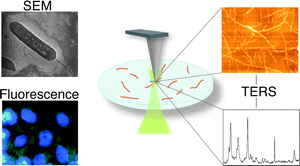
Phys. Chem. Chem. Phys., 2010,12, 12040-12049
https://doi.org/10.1039/C003316B
Surface-enhanced Raman spectroscopy of dyes : from single molecules to the artists’ canvas
Applications of SERS to single-molecule studies and pigment identification in fibers from historical textiles.

Phys. Chem. Chem. Phys., 2009,11, 7350-7359
https://doi.org/10.1039/B904733F
A facile chemical approach for preparing a SERS active silver substrate
A facile iodination of silver foil can boost the SERS intensity of Rhodamine 6G 29-fold after 24 h.
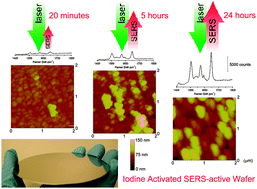
Phys. Chem. Chem. Phys., 2010,12, 14459-14461
https://doi.org/10.1039/C0CP00414F
Strong location dependent surface enhanced Raman scattering on individual gold semishell and nanobowl particles
We demonstrate strong localization of SERS on single symmetry-reduced gold semishell and nanobowl particle by the e-beam induced deposition (EBID) method.
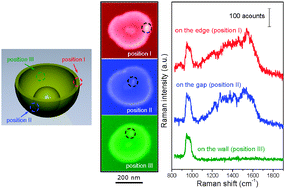
Phys. Chem. Chem. Phys., 2010,12, 11222-11224
https://doi.org/10.1039/C0CP00872A
SERS observation of soft C–H vibrational mode of bifunctional alkanethiol molecules adsorbed at Au and Ag electrodes
The soft C–H vibrational mode of alkanethiols adsorbed at Au and Ag electrodes was observed by SERS.
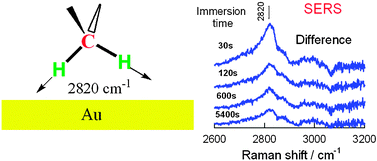
Phys. Chem. Chem. Phys., 2010,12, 4564-4568
https://doi.org/10.1039/B921291D
Tip-enhanced Raman scattering (TERS ) of oxidised glutathione on an ultraflat gold nanoplate
TERS spectra of a short immobilised peptide on a single transparent gold nanoplate are presented.
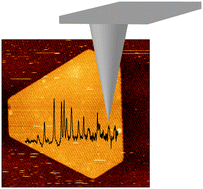
Phys. Chem. Chem. Phys., 2009,11, 7360-7362
https://doi.org/10.1039/B904735B
Surface-enhanced Raman spectroscopy with self-assembled cobalt nanoparticle chains: Comparison of theory and experiment
High quality surface Raman signals were obtained when PATP was adsorbed on a chain-like self-assembled cobalt nanoparticles surface.

Phys. Chem. Chem. Phys., 2010,12, 10781-10785
https://doi.org/10.1039/C002662J
Raman and SERS spectroscopy of cucurbit[n]urils
We present Raman spectroscopic evidence of ring strain with size in cucurbiturils and SERS detection at the ppb level.
![Graphical abstract: Raman and SERS spectroscopy of cucurbit[n]urils](/en/Image/Get?imageInfo.ImageType=GA&imageInfo.ImageIdentifier.ManuscriptID=C0CP00071J&imageInfo.ImageIdentifier.Year=2010)
Phys. Chem. Chem. Phys., 2010,12, 10429-10433
https://doi.org/10.1039/C0CP00071J
Templated fabrication of metal half-shells for surface-enhanced Raman scattering
A scalable colloidal templating approach for producing metal half-shells as efficient surface-enhanced Raman scattering (SERS) substrates has been developed.
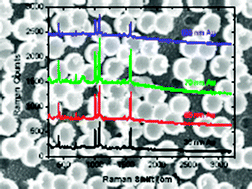
Phys. Chem. Chem. Phys., 2010,12, 1379-1387
https://doi.org/10.1039/B919916K
Chromic materials for responsive surface-enhanced resonance Raman scattering systems: a nanometric pH sensor
The potential for the incorporation of chromic materials into surface-enhanced resonance Raman scattering (SERRS) systems for ultrasensitive optical probes is demonstrated with the halochrome 4-(dimethylamino)azobenzene (methyl yellow).

Phys. Chem. Chem. Phys., 2009,11, 7505-7508
https://doi.org/10.1039/B904747F
Nanospheres of silver nanoparticles : agglomeration, surface morphology control and application as SERS substrates
Silver nanospheres with special surface morphology have been synthesized and optimized for application as SERS media.
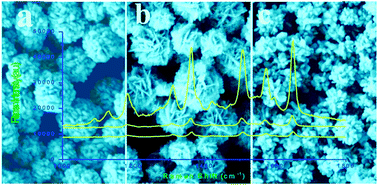
Phys. Chem. Chem. Phys., 2009,11, 7450-7454
https://doi.org/10.1039/B904712C
Redox molecule based SERS sensors
Nanobiosensors based on wired enzymes coupled to redox molecules and integrated with SERS Au core–shell nanoparticles and ordered nanocavities.

Phys. Chem. Chem. Phys., 2009,11, 7412-7423
https://doi.org/10.1039/B905600A
Interfacial redox processes of cytochrome b562
The interfacial redox process of cytochrome b562 immobilised on a coated electrode is analysed by (time-resolved) SERR spectroscopy.
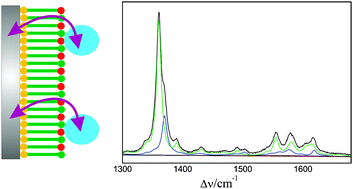
Phys. Chem. Chem. Phys., 2009,11, 7430-7436
https://doi.org/10.1039/B904926F
Single-molecule vibrational pumping in SERS
Single-molecule vibrational pumping in surface-enhanced Raman scattering is demonstrated rigorously using the bi-analyte method at low temperatures.
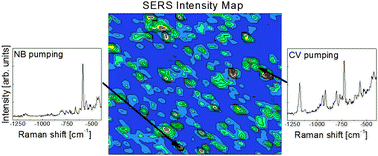
Phys. Chem. Chem. Phys., 2009,11, 7372-7380
https://doi.org/10.1039/B904638K
High performance gold nanorods and silver nanocubes in surface-enhanced Raman spectroscopy of pesticides
The behavior of Au nanorods and Ag nanocubes as analytical sensors was evaluated for three different classes of herbicides.

Phys. Chem. Chem. Phys., 2009,11, 7491-7498
https://doi.org/10.1039/B904734D
SERS imaging of HER2-overexpressed MCF7 cells using antibody-conjugated gold nanorods
We report the application of antibody-conjugated gold nanorods for the targeting and imaging of biomarkers expressed on cancer cells.
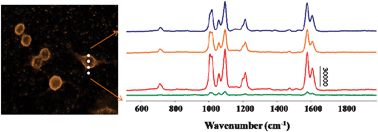
Phys. Chem. Chem. Phys., 2009,11, 7444-7449
https://doi.org/10.1039/B904592A
Ag-modified Au nanocavity SERS substrates
Renewable SERS-active substrates combining the durability and reusability of Au-nanocavity templates, with the enhanced SERS amplification factors of Ag.

Phys. Chem. Chem. Phys., 2009,11, 7469-7475
https://doi.org/10.1039/B904685M
Surface-enhanced Raman scattering studies of rhodanines : evidence for substrate surface-induced dimerization
In SERS experiments employing Ag nanoparticles, rhodanine is hypothesized to form a dimeric species via the active methylene group in a process analogous to the Knoevenagel reaction.

Phys. Chem. Chem. Phys., 2009,11, 7476-7483
https://doi.org/10.1039/B905008F
Investigation of particle shape and size effects in SERS using T-matrix calculations
T-matrix study of the interplay between shape and size effects on surface-enhanced Raman scattering enhancement factors.

Phys. Chem. Chem. Phys., 2009,11, 7398-7405
https://doi.org/10.1039/B905645A
Controlling the non-resonant chemical mechanism of SERS using a molecular photoswitch
A photoswitch can control the non-resonant chemical mechanism in SERS by altering its HOMO–LUMO gap.

Phys. Chem. Chem. Phys., 2009,11, 7424-7429
https://doi.org/10.1039/B904745J
SERS enhancement by aggregated Au colloids: effect of particle size
The enhancement given by 21–146 nm monodisperse Au colloids varies significantly with diameter and is largest with 46 nm particles.

Phys. Chem. Chem. Phys., 2009,11, 7455-7462
https://doi.org/10.1039/B906049A
Water soluble SERS labels comprising a SAM with dual spacers for controlled bioconjugation
Water soluble SERS labels comprising a SAM with dual spacers for controlled bioconjugation are presented.
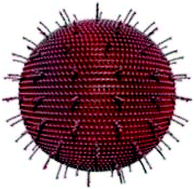
Phys. Chem. Chem. Phys., 2009,11, 7499-7504
https://doi.org/10.1039/B905092B
Silver nanoparticles self assembly as SERS substrates with near single molecule detection limit
Multiple depositions of Ag NPs on glass using a sol–gel linker yield a SERS substrate that approaches single molecule sensitivity.

Phys. Chem. Chem. Phys., 2009,11, 7381-7389
https://doi.org/10.1039/B904744A
Surface-enhanced Raman scattering of 5-fluorouracil adsorbed on silver nanostructures
SERS of 5-fluorouracil is analysed according to a resonant charge-transfer enhancement mechanism involving the N1 deprotonated anion.
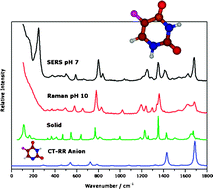
Phys. Chem. Chem. Phys., 2009,11, 7437-7443
https://doi.org/10.1039/B903823J
Plasmon-dispersion corrections and constraints for surface selection rules of single molecule SERS spectra
Plasmon-dispersion corrections constrain the observation of surface selection rules in single molecule SERS spectra.
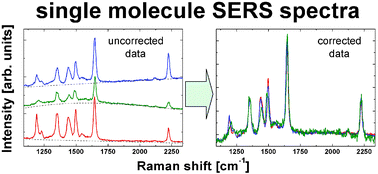
Phys. Chem. Chem. Phys., 2009,11, 7406-7411
https://doi.org/10.1039/B905846J
Towards a metrological determination of the performance of SERS media
Surface enhanced Raman scattering enhancement factors are investigated using optical pumping and photobleaching combined with a rigorous mathematical model.

Phys. Chem. Chem. Phys., 2009,11, 7463-7468
https://doi.org/10.1039/B904621F
Characteristics of surface-enhanced Raman scattering and surface-enhanced fluorescence using a single and a double layer gold nanostructure
SPR and SERS characteristics of colloidal nanoparticle-based layered gold nanostructure.
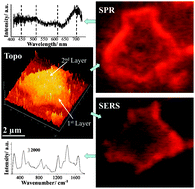
Phys. Chem. Chem. Phys., 2009,11, 7484-7490
https://doi.org/10.1039/B903819C
Gated electron transfer of cytochromec6 at biomimetic interfaces: a time-resolved SERR study
Time-resolved SERR spectroelectrochemistry studies demonstrate that the heterogeneous electron transfer of cytochrome c6 on biomimetic electrodes follows a gated mechanism.

Phys. Chem. Chem. Phys., 2009,11, 7390-7397
https://doi.org/10.1039/B904434E
Self-assembly of α,ω-aliphatic diamines on Ag nanoparticles as an effective localized surface plasmon nanosensor based in interparticle hot spots
The self-assembly of α,ω-aliphatic diamines on Ag nanoparticles was studied by surface-enhanced Raman scattering (SERS) spectroscopy and plasmon resonance. The analytical potential of these mixed systems was demonstrated.
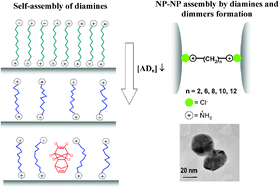
Phys. Chem. Chem. Phys., 2009,11, 7363-7371
https://doi.org/10.1039/B904631C
Influence of the close sphere interaction on the surface plasmon resonance absorption peak
Optical effects of agglomeration for small noble metal nanoparticle colloids are accurately calculated. Information about the surface plasmon resonance, electric field enhancement and surface charge distribution effects have been determined.

Phys. Chem. Chem. Phys., 2009,11, 5922-5929
https://doi.org/10.1039/B902489C
Probing the surface-enhanced Raman scattering properties of Au–Ag nanocages at two different excitation wavelengths
The surface-enhanced Raman scattering (SERS) of Au–Ag nanocages is investigated with two excitation wavelengths and reveals synergistic dependencies between metal composition, plasmon damping and SERS intensities.
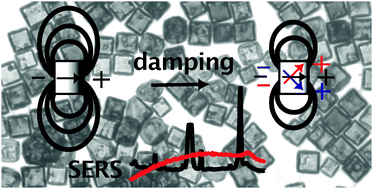
Phys. Chem. Chem. Phys., 2009,11, 5903-5908
https://doi.org/10.1039/B903533H
The effect of surface roughness on the plasmonic response of individual sub-micron gold spheres
Single particle Rayleigh scattering studies reveal that nanoscale surface roughness strongly affects the plasmon resonance of gold nanoparticles.
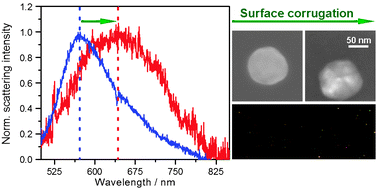
Phys. Chem. Chem. Phys., 2009,11, 5909-5914
https://doi.org/10.1039/B905200N
Self-assembly of a dithiocarbamate calix[4]arene on Ag nanoparticles and its application in the fabrication of surface-enhanced Raman scattering based nanosensors
The functionalization of Ag nanoparticles and its application in the detection of pyrene was studied by surface-enhanced Raman scattering.
![Graphical abstract: Self-assembly of a dithiocarbamate calix[4]arene on Ag nanoparticles and its application in the fabrication of surface-enhanced Raman scattering based nanosensors](/en/Image/Get?imageInfo.ImageType=GA&imageInfo.ImageIdentifier.ManuscriptID=B812811A&imageInfo.ImageIdentifier.Year=2009)
Phys. Chem. Chem. Phys., 2009,11, 1787-1793
https://doi.org/10.1039/B812811A
About this collection
Surface-Enhanced Raman Scattering (SERS) web collection: 33 high quality articles neatly grouped in one handy collection.